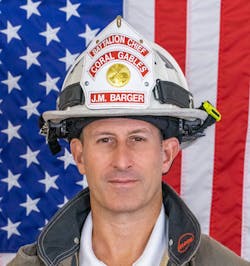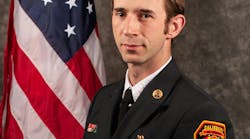It’s a typical day in your fire station. You are a newly ranked officer in your department, and your crews aren’t overly critical of your leadership style that day. The calls are going smoothly, and you believe that it’s going to be a quiet night.
As everyone sits down to dinner, the tones drop. You’re dispatched to a building fire with multiple calls coming in. You rush to your truck. En route, you receive further information that indicates “flames showing at a multiresident housing development with the possibility of people being trapped.” Your heart races so fast that you have issues getting on your SCBA.
You arrive to find a working fire with flames showing. You feel the effect of tunnel vision setting in, and you begin to lose the ability to focus on what needs to happen next. Crews arrive and ask for directions. Everyone is looking forward to your first move.
In all of the chaos, it is time to be still. Breath is essential to life, particularly in the life of a fire officer.
For those who are fortunate, the right seat on any fire apparatus is a place of pure excitement—or one of trepidation. The officer’s position can make you a leader in the eyes of your crews, or it can break you. Of course, everyone aspires to be the officer who they would want to follow and feel safe working with.
Officers who have some time under their belt experienced those calls that make their heart race, their mind dump and their body feel as though it’s going in slow motion or not working at all.
Even with our best training, why does this happen? Better yet, how do we manage it?
Composure
The feeling that’s described above is known as situational stress. It’s caused by the fear of the unknown. This creates a myriad of physiological and psychological events.
To understand why this happens, we must look at the physiological response in stressful situations.
When a stressful event is experienced, the amygdala, which is an area in the brain that’s the emotional processing center, sends a distress signal to the hypothalamus. The hypothalamus then sends a signal to the sympathetic nervous system through the autonomic nerves to the adrenal glands. The adrenal glands pump the hormone epinephrine into the bloodstream.
This surge of adrenaline increases the heart rate, which communicates to the nervous system that it’s time to fight or flight. However, unfortunately, at 115 beats per minute (bpm), fine motor skills, dexterity and hand-eye coordination start to deteriorate. At 145 bpm, complex motor skills and the ability to hear deteriorate. At 175 bpm, cognitive processing deteriorates, there’s loss of peripheral vision and depth perception, and there can be short-term memory loss and/or critical-stress amnesia. This isn’t what you need when you’re deciding what’s the right course of action and how to best mitigate an incident.
You must reduce your heart rate to return to a state of composure, to make sound judgements and to be calm on the radio.
I came up with an acronym to help you to return to your state of composure. In any situation you must be STILL.
Stop: Arrive on scene and stop. Do your size-up of the situation and assess what must be done. Don’t go into action mode. Instead, take this time to step back and look at the full picture. See what there is to do and what are the incident priorities and safety hazards to your personnel. What crews are en route? Who else should be dispatched to help? Use your training acronyms—COAL WAS WEALTH (construction, occupancy, area, life hazard, water, auxiliary systems, street conditions, weather, exposures, apparatus & personnel, location, time, hazards)—or gather your CAN (conditions, actions, needs) to further understand the incident.
Three deep breaths: Take three breaths using the box breathing technique, which starts your ability to control your emotions and heart rate. Box breathing, which also is known as tactical breathing and combat breathing, is a tool to help to reduce physiological stress levels before, during and after high-risk encounters. It can help some people who are experiencing peak levels of stress to rapidly regain control of their mind and body: inhale for five seconds, hold for five seconds, exhale for five seconds, hold for five seconds. (Some definitions peg the number of seconds at three or four.)
Simply put, your breathing is connected to your brain and nervous system. Your autonomic nervous system (ANS) controls your breathing and helps to regulate every other system in your body. The ANS includes your endocrine (hormone), cardiovascular, immune and digestive systems. That’s why when you start box breathing, you can adjust your nervous system to slow down and calm your ANS. This regulates the hormone release and brings you back to a readiness to do your job as an officer of a company or of the overall scene.
Investigate: Investigate why you were dispatched to the scene. What is the reason that you and your crew are there? Is it life safety, incident stabilization, property conservation or all of the above? Walk 360 degrees around the situation to understand what’s happening. Listen to what your crews are relaying back to you. This shouldn’t be done only on fire-related incidents but hazmat, technical rescue, EMS and active shooter calls, too. What are the incident conditions? What are the signs and symptoms of your patients? What must be searched or uncovered? Can you stabilize the scene with what was dispatched?
Locate: At the end of the investigation, you should be able to locate your objective or origin of cause, be it a fire incident, motor vehicle accident, or medical or trauma call. This now is where you can place the majority of your resources, giving you a specific location for your crews to work or to shelter others away from any dangers.
Lead: This is your opportunity to mitigate the situation with your crew(s), to lead them and place them in the right areas of the incident to provide the maximal amount of life safety, incident stability and property conservation. You will lead your crews with a clearer mind. This will pay off significantly, because you will be able to convey controlled communication to the crews that were sent to help those who are in need of rescuing from their situation.
A useful tool
Our breath is essential to life and firefighting. Learning to control your body with STILL will help you to make the critical decisions that are vital for the safety and well-being of your crew and victims.
When life depends on you, breathe to be the calmest individual on scene.






